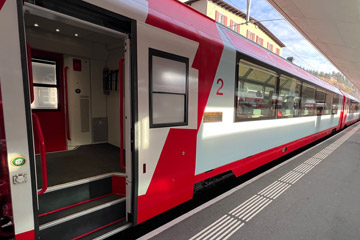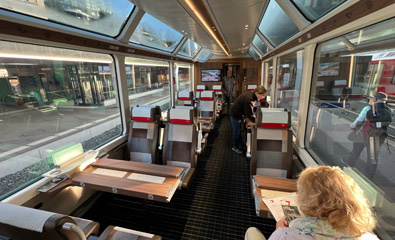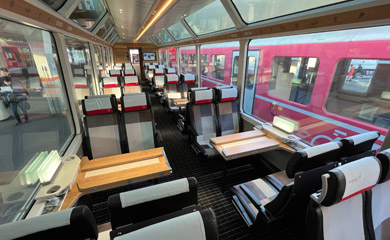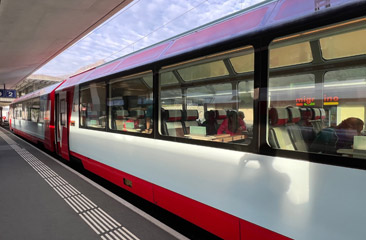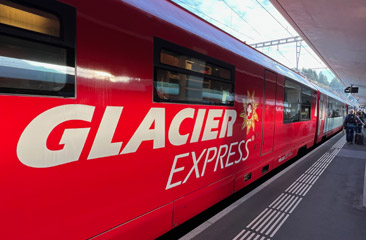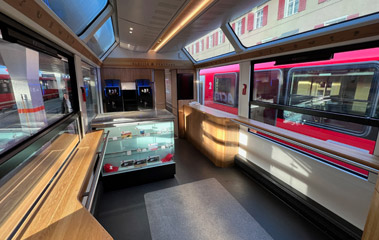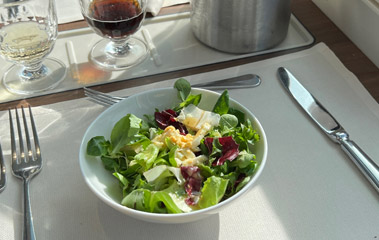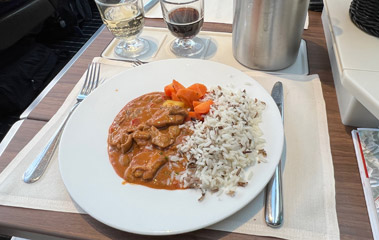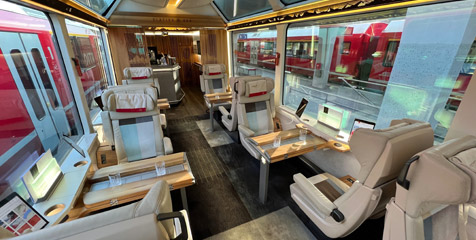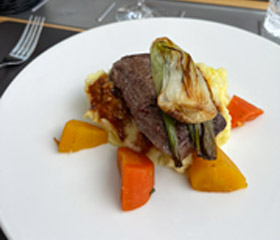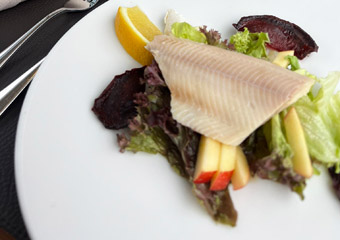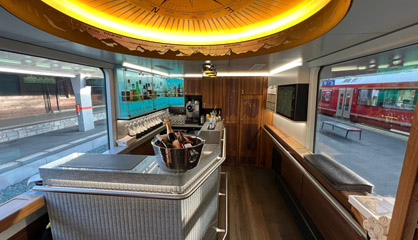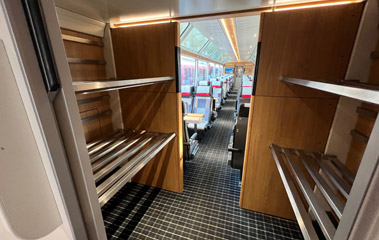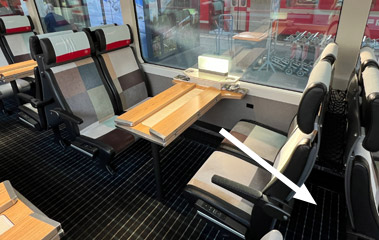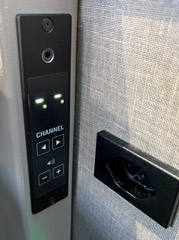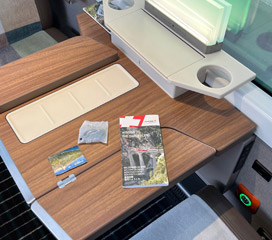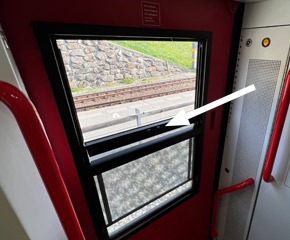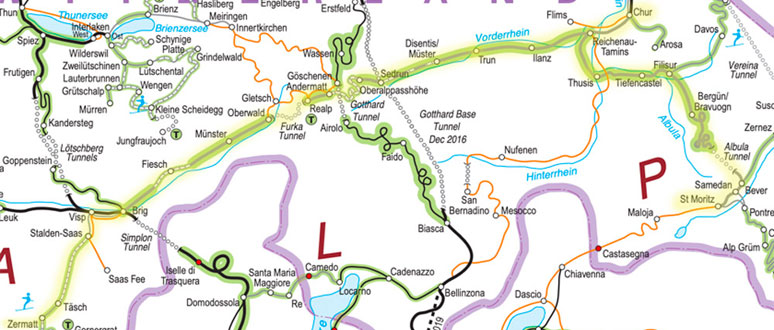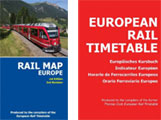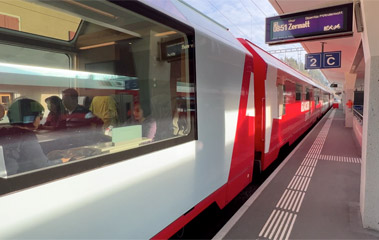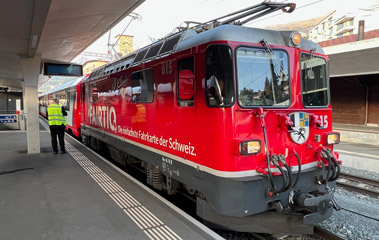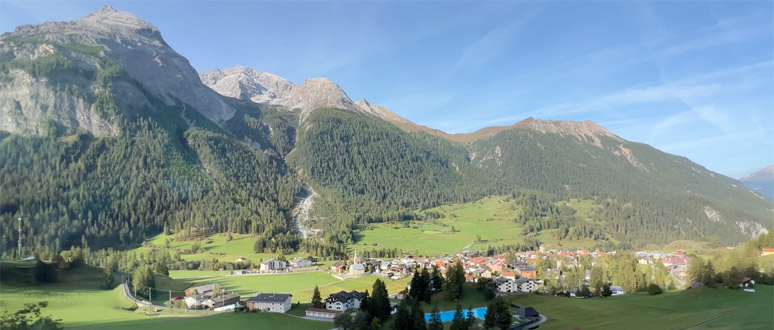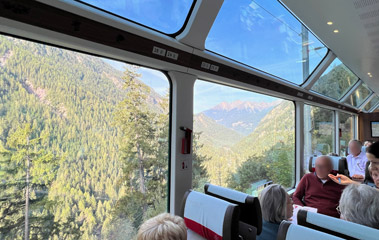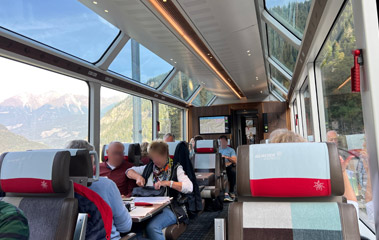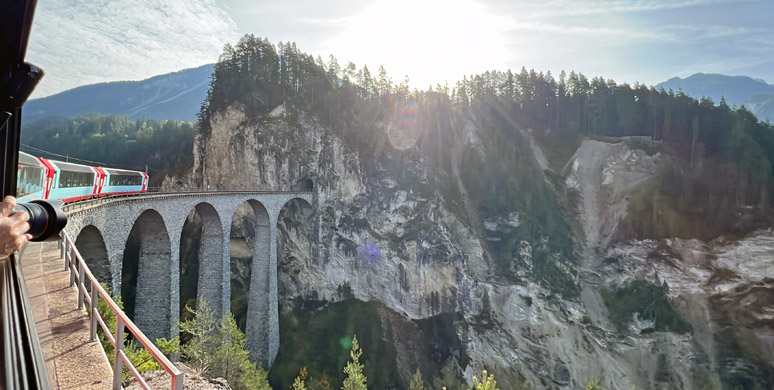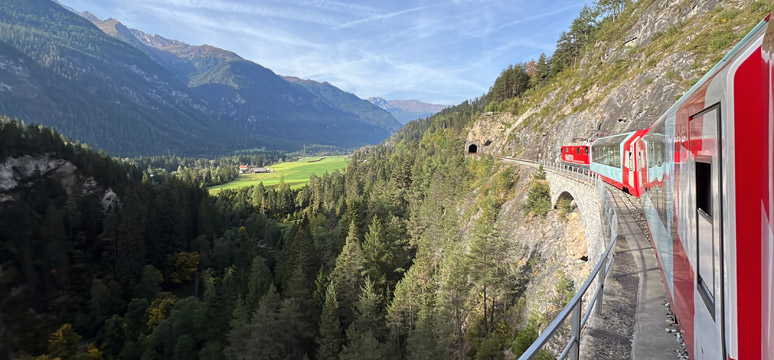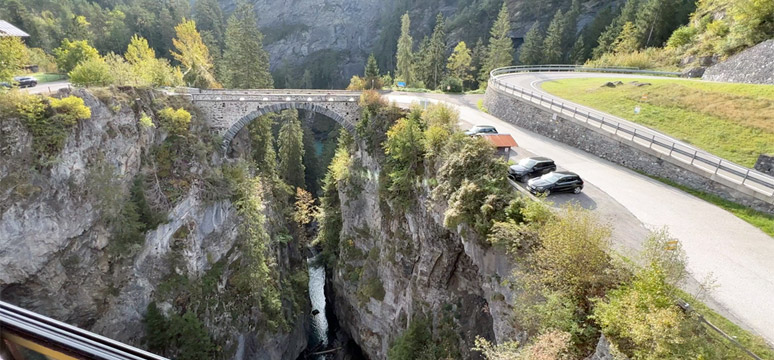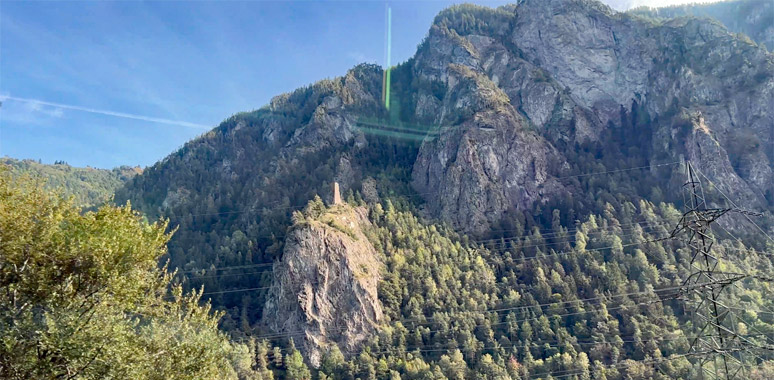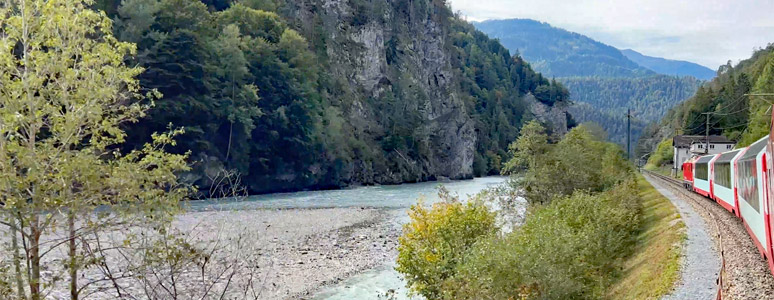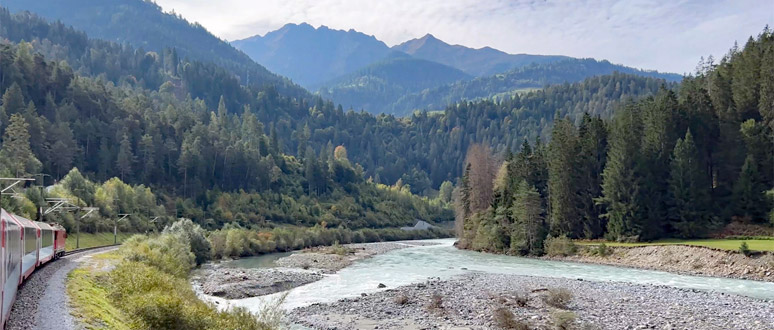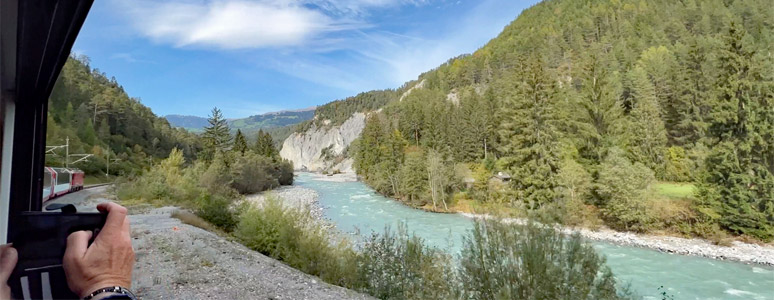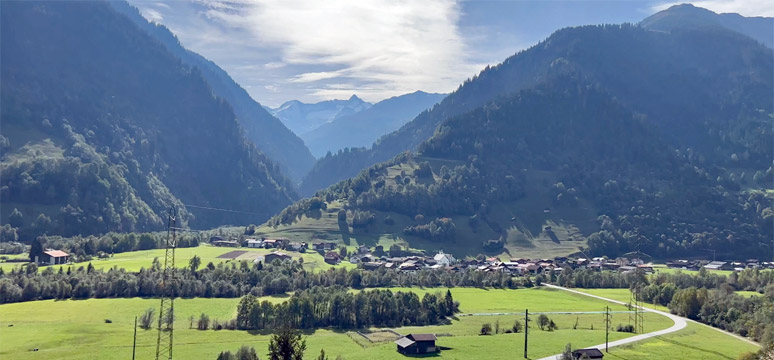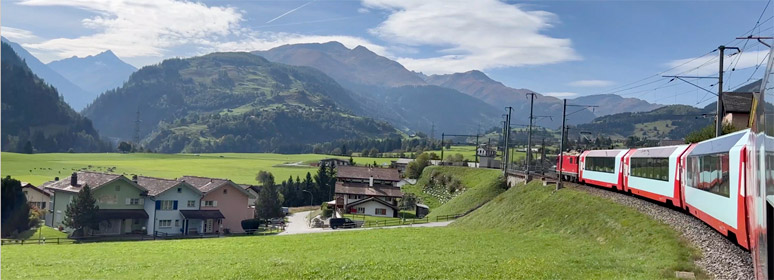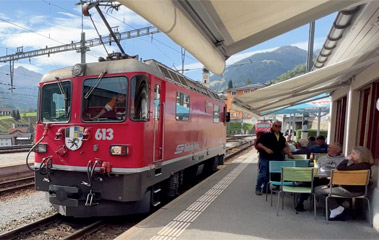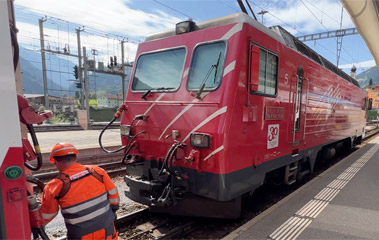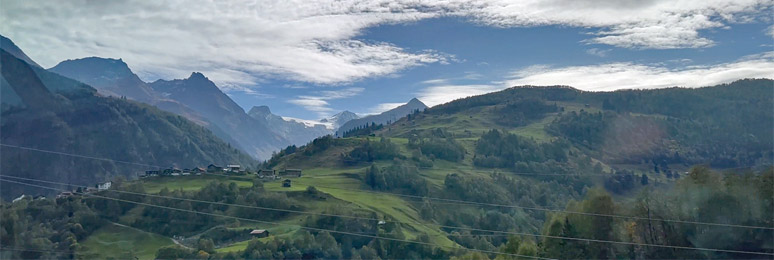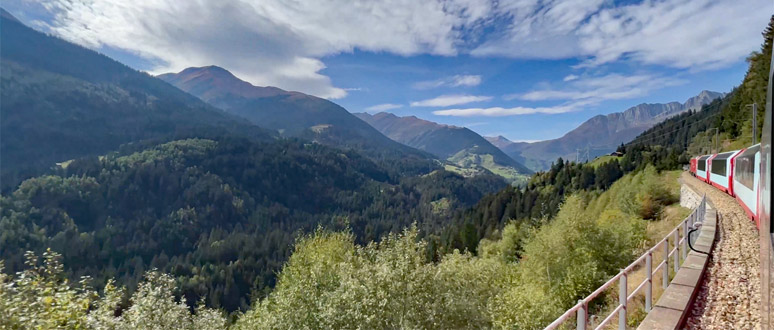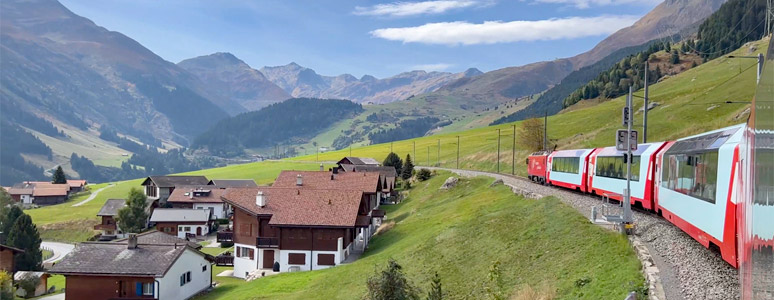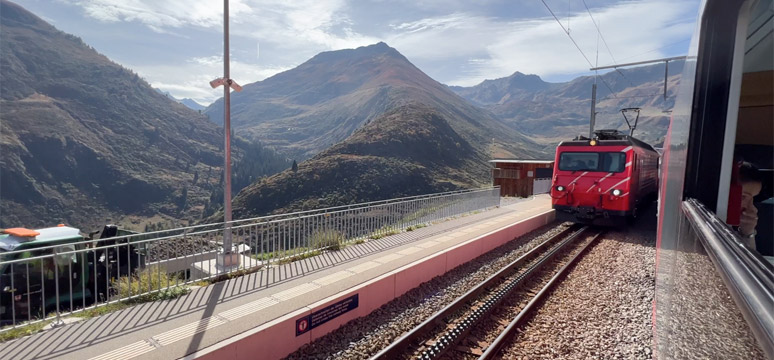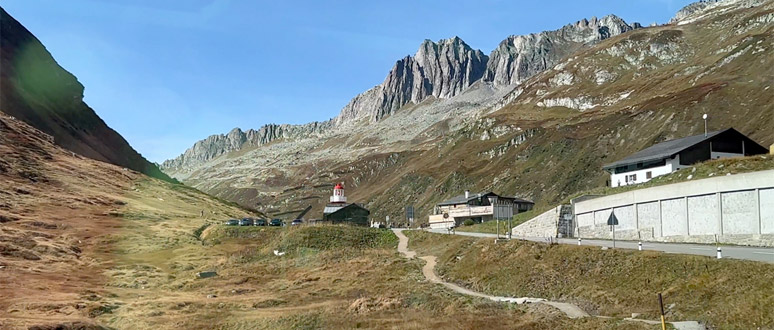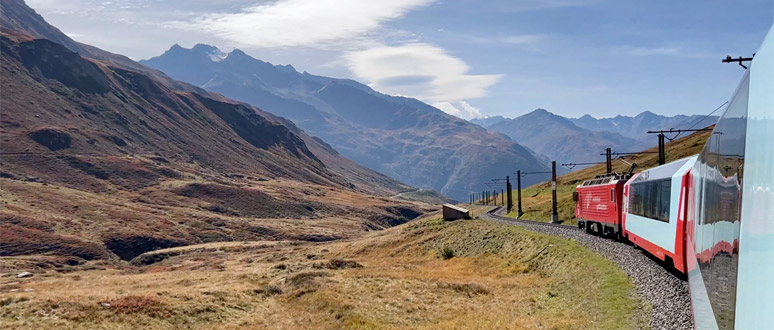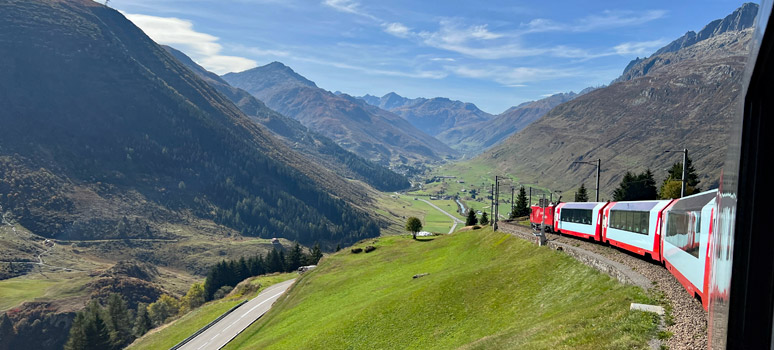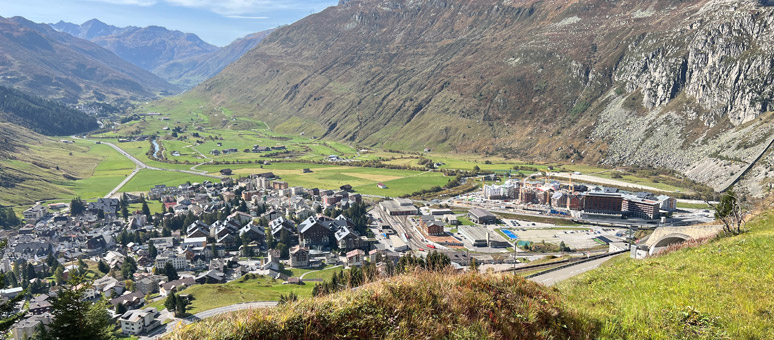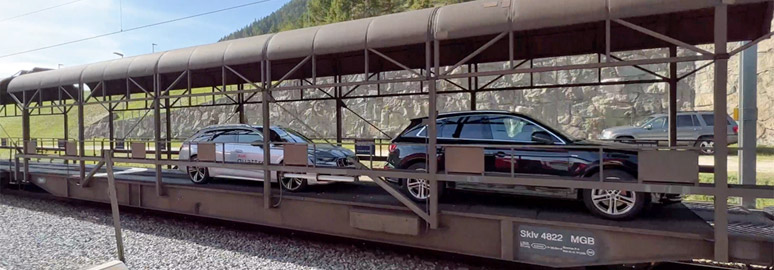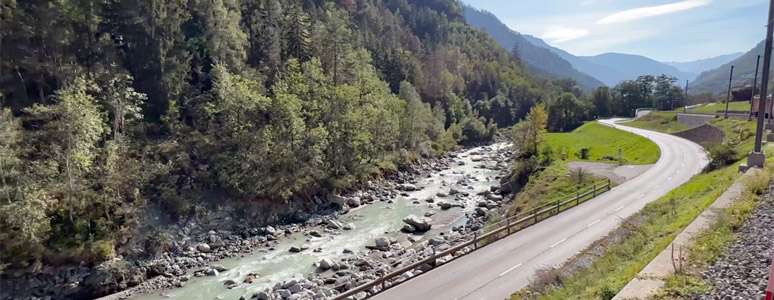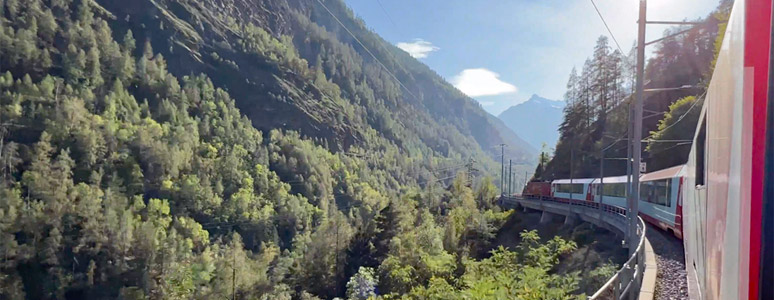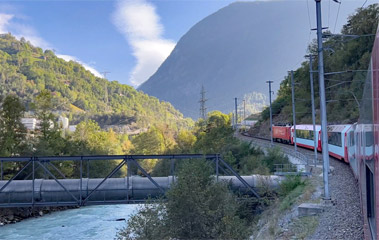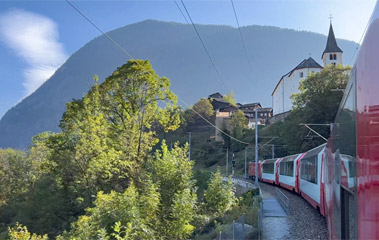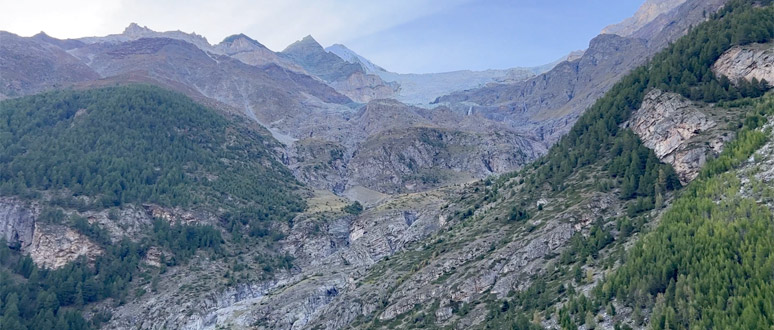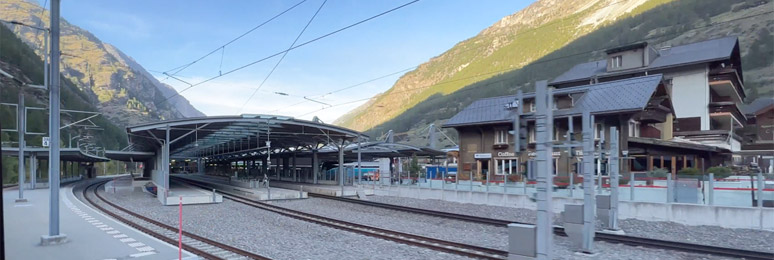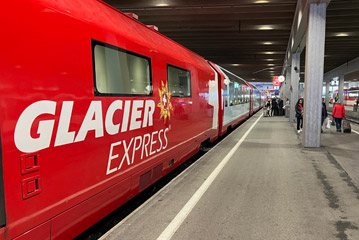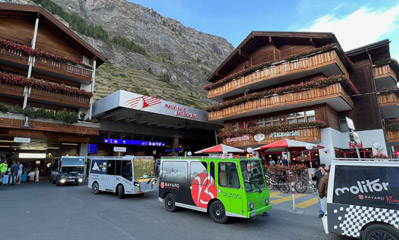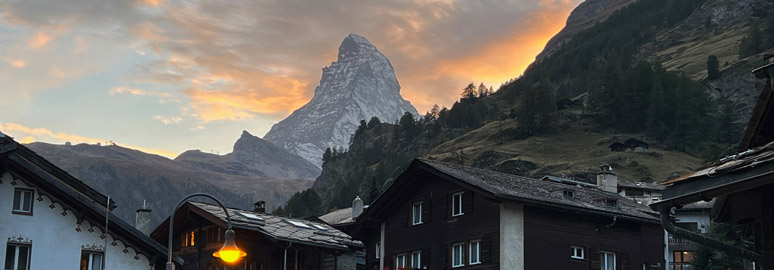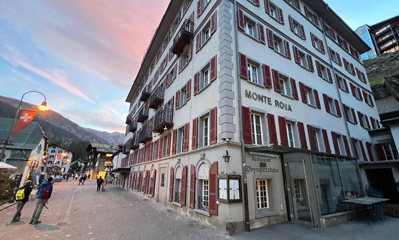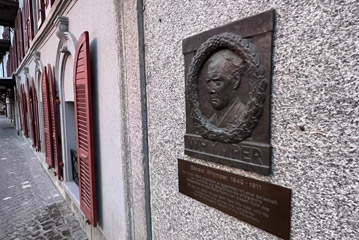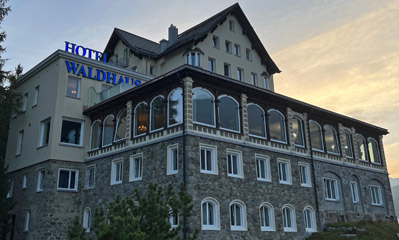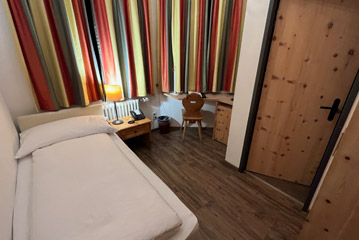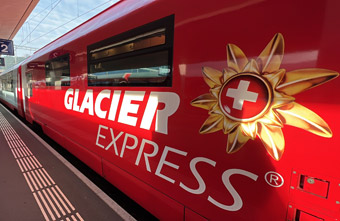 |
St Moritz to Zermatt by panoramic train
The Glacier Express & Bernina Express are Switzerland's two most scenic train journeys - which has the edge? Darned if I know, you'll just have to do both. Twice, as they're totally different experiences in summer and winter. Billed as Europe's slowest express, the narrow-gauge Glacier Express links St Moritz in the Engadin skiing area and Zermatt at the foot of the Matterhorn, taking 7½ hours to cover just over 290 km (180 miles) at an average speed of 24 mph. Spectacular Swiss scenery unfolds outside the panoramic windows while you eat lunch accompanied by Swiss white wine.
The Glacier Express is run jointly by the Rhätische Bahn (RhB) & the Matterhorn Gotthard Bahn (MGB) who also operate the regular local trains on the same route. In 2017 they formed a separate company to run the Glacier Express, Glacier Express AG. There are one or two daily Glacier Expresses in each direction in winter, more in summer.
Glacier Express timetable
Winter = 6 December 2025 to 1 May 2026
Summer = 2 May to 10 October 2026.
There is no Glacier Express service at all from 12 October to 5 December 2025 or from 11 October until early December 2026.
* = Trains 920 & 905 run from 13 December 2025 to 4 January 2026 and from 31 January to 1 May 2026.
f = To/from Davos, change trains at Filisur, using the hourly branch line train between Filisur & Davos.
How much does it cost?
To travel on the Glacier Express you need two separate things: A valid ticket and a Glacier Express seat reservation. The ticket can be a standard price point-to-point ticket (prices shown below) or a Saver Day Pass (which is usually cheaper) or an Interrail pass, Eurail Pass or Swiss Travel Pass.
Children under 6 go free, but without their own seat. Children aged 6 to 16 pay half fare but must pay the adult reservation fee.
How to buy tickets
-
First some explanation. Listen up, I'm going to save you some money.
You need two things to travel on the Glacier Express: (1) A seat reservation which secures your place on the train and (2) any sort of valid ticket for the class you've reserved.
The ticket can be a regular point-to-point train ticket or it can be a Saver Day Pass, Swiss Travel Pass or Interrail or Eurail pass.
I recommend buying the seat reservation first, then buying the ticket separately.
Why? Because the Glacier Express website only sells expensive full-flex standard-fare tickets, even when a much cheaper Saver Day Pass covers the whole Glacier Express route. Wouldn't you rather pay CHF 52 for a Saver Day Pass than CHF 152 for a full-price ticket? Here's how:
-
Step 1, make a seat reservation.
Go to the official Glacier Express website, www.glacierexpress.ch and run an enquiry for your journey.
Reservations open 93 days ahead. Select Classic Glacier Express for normal 1st & 2nd class, or select Excellence class.
If you're booking a few months ahead, it may warn you that it can only sell a reservation at this time, which is what you want anyway.
Select the train you want, then select seats from the seat map. Don't worry about the price shown at this stage.
You can't tell which seats face forward or which side of the train they'll be, because the system has no idea which way round the carriage will run. I recommend that a couple book face-to-face window seats, a family books 4 seats around a table.
Now the science bit: On the page where you enter your personal details, change the Reduction drop-down box to Reservation only.
You should see the price drop to the cost of a Glacier Express seat reservation shown in the fares section above.
Buy the reservation, you are then safely booked on the Glacier Express!
In principle, you could now simply buy a standard-price ticket at the station 10 minutes before the train goes, these have unlimited availability and cannot sell out. But it's a lot cheaper to buy a ticket in advance, as in step 2.
-
Step 2, buy a ticket.
If you have a Swiss Travel Pass, Interrail or Eurail pass, you already have a ticket, no further action necessary.
But if you don't have such a pass, here's how to buy a ticket. Tickets go on sale 6 months ahead. You can't buy before sales open.
Go to Omio.com and run an enquiry for the journey you wish to make, for example St Moritz to Zermatt.
Find your train and select it. Look for a train with 0 changes, just remember there is more than one Glacier Express a day in summer - although as Saver Day Passes are good for any train, it doesn't matter if you pick the wrong one.
If a Saver Day Pass is available it will be offered, usually as the cheapest option. Select it in the class you want, which must (obviously!) be for whichever class of seat you've reserved.
Go ahead and buy it. You can print it out or show it on your phone.
A Saver Day Pass gives unlimited travel all day all over Switzerland on all main train routes including the MGB & RhB who run the Glacier Express. The price varies depending how far ahead you buy it and how popular that day is. More about Saver Day Passes.
Omio.com is really easy to use, there's a small booking fee and I get a little commission if you book this way. You can buy tickets & Saver Day Passes without a booking fee at www.sbb.ch but it's a bit more fiddly, it may default to a Half Fare Card 50% discount which you must remove before buying.
Note that although Omio.com appears to 'book' you on the Glacier Express, in fact it only sells you an open ticket, not the compulsory Glacier Express reservation. But if you've followed my instructions you'll already have that.
If you've an Interrail, Eurail or Swiss Travel Pass
-
Interrail & Eurail passes cover the Rhätische Bahn (RhB) and the Matterhorn Gotthard Bahn (MGB) so cover the whole Glacier Express route. Until 2017, Eurail & Interrail gave free travel on the RhB part of the trip, but only a discount on MGB. They now give free travel on both.
-
So all you need is a Glacier Express seat reservation, see the reservation prices above. You can even travel in Excellence class if you have a 1st class pass and make an Excellence class reservation.
-
To make a reservation, follow step 1 in the How to buy tickets section above. You do not need to follow step 2 if you have a pass.
Holidays & tours on the Glacier Express
-
Railbookers: For a custom-made trip on the Glacier Express with trains, transfer & hotels arranged as a package, call train travel specialists Railbookers. Check out two of their top sellers: 8-day Switzerland's Lakes & Mountains tour (link to their UK site) or Swiss Lakes & Mountains tour (link to their US & Canada site) which includes both Glacier Express & Bernina Express trains, and their shorter 5-day Classic Bernina Express & Glacier Express tour (link to their UK site) or Classic Bernina Express & Glacier Express tour (link to their US & Canada site) which also combine these two classic Alpine routes.
 UK call 0207 864 4600,
www.railbookers.co.uk
UK call 0207 864 4600,
www.railbookers.co.uk US 1-888-829-4775,
www.railbookers.com
US 1-888-829-4775,
www.railbookers.com Canada 1-855-882-2910,
www.railbookers.com
Canada 1-855-882-2910,
www.railbookers.com Australia 1300 971 526,
www.railbookers.com.au
Australia 1300 971 526,
www.railbookers.com.au New Zealand 0800 000 554 or
see
website
New Zealand 0800 000 554 or
see
website
-
Tailor Made Rail can also organise a trip to Switzerland by train, with hotels and transfers arranged as a package. Call their dedicated seat61 phone line 020 3778 1461 and quote seat 61 when booking. From outside the UK call +44 20 3778 1461. Lines open 09:00-17:30 Monday-Friday. Their website is www.tailormaderail.com/trains/glacier-express-holidays.
-
Byway (Byway.travel) is a UK-based eco-holiday firm with a 5-star TrustPilot rating. If you're nervous about booking train travel yourself, they'll book a holiday to Spain for you as a package, including train travel from the UK and hotels, starting from any British station you like. Byway includes package protection, a 100% Covid refund guarantee, free disruption & re-planning and on-demand WhatsApp support while you're away.
To see pre-configured packages from the UK to Switzerland by train, www.byway.travel/.../switzerland-by-train.
Or they can build a trip to your requirements, call 0300 131 7173 (open 09:00-17:00 Monday-Friday, from outside the UK call +44 300 131 7173) or email them or use this contact form. Please say you heard about them from Seat 61.
What's it like on the Glacier Express?
The Glacier Express uses coaches specially built in 2006, clean, comfortable, carpeted and air-conditioned, with huge panoramic side windows and glass skylights.
1st class seats are arranged 2+1 across the car width, with bays of 4 seats around a table one side of the aisle, bays of 2 seats across a table on the other.
2nd class seats are arranged 2+2 across the car width, with bays of 4 around a table on both sides of the aisle.
The biggest benefit of 1st class is that couples can book a face-to-face table for two, solo travellers can book a seat which is both window and aisle with no-one sitting next to them. Other than that, 1st class simply means more elbow room and fewer passengers per car, on-board service is exactly the same. Glacier Express seat map.
Both classes have power sockets and free WiFi. You'll get a free printed route guide with an explanation of the key sights and route map. There are free headphones which you can plug in to listen to the commentary. Video screens at the end of the car show the train's location and other information.
There is a bar car, but no need to visit it as staff come down the train taking orders for tea, coffee, alcoholic and soft drinks & snacks, also for a 2, 3 or 4 course lunch. You can pre-book lunch, served at your seat on real china with proper cutlery, with a choice of starters, main courses and desserts, accompanied by a good selection of wines. You can find sample menus & wine list at www.glacierexpress.ch under Travel planning then Gastronomy. Or feel free to bring your own picnic and bottle of wine.
Lunch served at your seat in 1st or 2nd class. A 2, 3 or 4-course lunch can be ordered and paid for in advance when you reserve, or you can order and pay on the day.
Excellence class
Since 2019 there's a premium option called Excellence class, only available on trains 902 & 903/923. It's become incredibly popular and gets booked up fast.
Excellence class consists of one deluxe panoramic car with seats arranged 1+1 across the car width, face-to-face tables for two on both sides of the aisle, so everyone gets a window seat. There's a cocktail bar at one end of the car for Excellence class passengers. A 5-course regional menu with wine is included in the reservation fee, as is complimentary coffee, juice, snacks & champagne. A dedicated Excellence class host travels with the car. See the 360º photo of Excellence class here (please let me know if this link stops working).
To travel in Excellence class you need a first class ticket (or 1st class Interrail, Eurail, Saver Day Pass or Swiss Travel Pass) then you pay the Excellence class reservation fee. You can make the reservation at www.glacierexpress.ch and print it out, but I recommend buying a Saver Day Pass separately rather than paying for a full-price ticket, see the prices and advice on tickets above.
Traveller James Morris reports: "Excellence Class is brilliant. A professional concierge service helps you with your bags and shows you to your seat. They are friendly and chatty, nothing is too much trouble. They are clued up on the food and drink they serve and explain it all to you. They wear white gloves when serving, and know how to open and pour champagne. I had iced tea all trip with spring water and herbs, best iced tea ever. I was never without a drink in front of me all trip. They refill glasses or get you a new bottle of water without a second thought. For those that do drink. It was champagne to start, followed by a different wine for each course of the meal. They served a full 7 course meal, amazing food. The seats are very comfortable with good recline, and full lumbar adjustment. A shelf by the side of your seat has easy to reach sockets & USB charger. An IPad was provided to help you follow the journey. A Glacier Express tilting glass was given as a souvenir at the end of the trip, along with Excellence class branded chewing gum or hand cream. On arrival, you are told to just leave the train, someone comes on board to carry your bags off. It exceeded my expectations, which isn't bad considering the price. Definitely a must do if you can afford it."
Travel tips & FAQ
-
What time of year is best?
You can go almost any time, the Glacier Express runs all year apart from a short break from late October to mid-December when the MGB does annual maintenance on the Brig-Zermatt line, see the timetable above. Indeed, you really need to do it twice, once as a summer jaunt through sunny green meadows and again through a winter wonderland. You can still go in the October-December period when there's no Glacier Express using local trains on the same route, with a change of train or two somewhere, use www.sbb.ch to find times.
-
Is eastbound or westbound better?
It makes little or no difference, scenery is the same in either direction and all the trains do the whole run in daylight even in winter. Arguably, Zermatt is the nicer destination to end up in for a short stay.
-
Should you go first or second class?
The scenery is exactly the same whether you choose 1st or 2nd class and the on board service is the same, too. The only difference is the seating layout, see the photos above. As you can see, 2nd class seats are arranged 2+2 across the car width, 1st class seats 2+1, so 1st class seats offer more elbow room and fewer passengers per car. It also means that there are tables-for-two on one side of the aisle, which are nicer for couples than sharing a 4-seater section in 2nd class. But on-board service is exactly the same, all you're paying for is more room. 2nd class is absolutely fine.
-
Which side of the train to sit?
When booking, you can't tell which way round the carriages will be so you can't reserve a seat on a specific side. However, eastbound from Zermatt, the right-hand side is best along the Mattertal Valley from Zermatt to Brig, but in the Rhine Gorge, all the river scenery is on the left. The train changes direction in Chur. Then from Chur to St Moritz the best views are on the right hand side, including the classic view as the train curves onto the Landwasser Viaduct. Westbound from St Moritz, it's obviously the opposite side in each case.
-
Opening windows for photography or video
The panoramic windows are great for viewing, but the double glazing isn't ideal for reflection-free photography. There are two solutions: In each passenger car, the droplights in the entrance doors open: Pinch together the two small knobs at the top of the window to lower it. In the bar car, one large window on each side pulls right down, quite a few passengers gather in there to photograph key sights such as the Landwasser Viaduct! Obviously, don't lean out, just point your camera through the open window, staff won't mind if you're careful.
Incidentally, in Excellence class the end-of-car vestibule is used for service and food & drink are served almost continuously, so you won't be popular if you keep bobbing up & down to take photos. Perhaps it's better not to book Excellence class if you intend spending much of the time taking photographs or video at an open window!
-
Luggage on the Glacier Express
Like any other European train, you take your luggage onto the train with you and put it on the luggage racks. Within reason you can take whatever you like, suitcases, backpacks, whatever, as long as you can carry it yourself. There are large luggage racks in each car, just inside the seating area, see the photos below. You can also put bags between the seat backs.
-
Food on the Glacier Express
There's a bar car in the centre of the train selling tea, coffee, snacks and souvenirs. But you don't need to visit it. In 1st & 2nd class, staff come down the train at regular intervals taking orders for food and drink, and a 2, 3 or 4-course lunch can be served at your seat at extra cost. You settle up at the end of the journey. Or you're free to bring your own picnic and even wine on board, as on other European trains.
Route map
Yellow highlighted = Zermatt-Brig-Chur-St Moritz by Glacier Express. Green = scenic sections of line. Orange = bus
Dashed railway line (e.g. around Fiesch) = section where train uses rack-&-pinion to grip because of steep gradient.
Dotted railway line (e.g. Furka Tunnel) = tunnel.
Reproduced from the excellent European Rail Map with kind permission of the European Rail Timetable people. I recommend buying a copy of the European Rail Map for your travels, www.europeanrailtimetable.eu with shipping worldwide.
The journey in pictures
St Moritz, 1,775m above sea level. This is the view across the lake from the Hotel Waldhaus am See, the station is visible on the right.
The Glacier Express is backed into the station half an hour before departure.
The scenery starts almost immediately after leaving St Moritz.
Between Samedan & Filisur
Landwasser Viaduct, looking back from the large opening window in the bar car. Many publicity photos are taken here.
Looking forwards when crossing the Landwasser Viaduct.
Crossing the short Solis Viaduct.
Juvalt Castle, dating from 1216. The castle guards a pinch point in the valley, through which the trade routes pass.
Chur, 585m above sea level. The train passes Reichenau and reaches Chur, Chur is a dead-end terminus and the train changes direction here.
Rhine Gorge. The train leaves Chur, passes back through Reichenau and soon afterwards starts snaking along the River Rhine.
The train follows the river for quite a way.
Another shot of the Rhine gorge
Between the Rhine Gorge and Disentis
Approaching Disentis.
Disentis. This is where the Rhätische Bahn (RhB) hands over to the Matterhorn Gotthard Bahn (MGB) and the locomotive is changed. You can stretch your legs here!
Climbing away from Disentis.
Heading for the Oberalp Pass.
Starting the climb.
Passing an eastbound Glacier Express. Note the rack between the rails, this section is too steep for unaided adhesion.
Oberalp Pass, the highest point on the journey at 2,033m above sea level. The lighthouse is a 2010 replica of one that once stood at Hoek van Holland and is now in the Maritime Museum in Rotterdam. The source of the Rhine is a stone's throw away from here.
Descending from the Oberalp Pass.
Approaching Andermatt
Andermatt and its station are visible way below.
Furka Tunnel: After Andermatt the Glacier Express passes through the 15.4 km Furka Tunnel, opened in 1982. You may see cars & lorries on transporter wagons being shuttled through the tunnel, especially in winter when the pass over the top is closed. Year-round service on the railway was only possible when the tunnel opened. Incidentally, the train is named after the Rhône Glacier on the Furka Pass which is no longer visible from the train since the tunnel opened, although you may see other glaciers high in the mountains at points along the train's route.
Between Andermatt & Brig.
Brig, 691m above sea level. The metre-gauge MGB platforms are in the road in front of the mainline SBB (Swiss Railways) station.
The train runs alongside the mainline SBB tracks from Brig to Visp, then heads off on the line to Zermatt ascending the Mattertal Valley.
Rack and pinion is used on the steeper sections as the train climbs relentlessly towards Zermatt, along the Matter Vispa river.
Getting higher...
Looking back at Tasch rail terminal. Zermatt is car-free, road vehicles park at Tasch, from where shuttle trains run to Zermatt.
Zermatt, 1,804m above sea level. The town is car-free, those electric vehicles are taxis.
End of the line: Zermatt nestles at the foot of the imposing 4,477m Matterhorn.
Video: A journey on the Glacier Express
Take a winter trip!
The Glacier Express runs all year apart from a few weeks break from mid-October to early December. The journey through winter snow is a completely different experience from the same journey past summer meadows! The train is less busy in winter and easier to get seats, too. Photo courtesy of David Saville.
A brief history of the Glacier Express
After the first world war, Switzerland steadily gained popularity as a winter and summer holiday destination for those who could afford it. Railways grew up to support this tourism, and through services on he metre-gauge line between Brig, Chur and St Moritz started in 1926. But it was in June 1930 that the first Zermatt to St Moritz 'Glacier Express' started running, initially summer only, and run jointly by the BVZ (Brig-Visp-Zermattbahn), FOB (Furka Oberalp Bahn) and RhB (Rhätische Bahn). It could not run all year because of the impossibility of keeping the line over the Oberalp pass open in winter. Construction of the Furka base tunnel started in 1973, and at long last in 1982 all-year operation was inaugurated between Zermatt and St Moritz. BVZ and FOB merged in 2003 to form the MGB (Matterhorn Gotthard Bahn). The Glacier Express has been progressively developed as a premier tourist attraction in its own right, and rightly so, though it continues to form an integral part of the Swiss transport network. More info at en.wikipedia.org/wiki/Glacier_Express.
More information
The Glacier Express website is www.glacierexpress.ch, where you can check up to date times & fares, and the current menu.
You can read more history & background at en.wikipedia.org/wiki/Glacier_Express.
Hotels in Zermatt
The Monte Rosa Hotel is the most famous & historic place to stay if your budget allows. This was the first hotel in Zermatt and it was from here that Edward Whymper set out on the first successful ascent of the Matterhorn in 1865. It's right in the centre of the town only 400m from the station, with a superb 9/10 review score.
Otherwise (assuming your budget won't stretch to the other top-notch place directly opposite the Monte Rosa, the Grand Hotel Zermatterhof, opened in 1879), a much more affordable and down-to-earth choice close to the station in Zermatt's main street is the clean & comfortable Hotel Garni Testa Grigia. Or just search booking.com, anything with a review score over 8.0 will be great.
The famous Monte Rosa Hotel and plaque dedicated to Edward Whymper, see larger photo.
Hotels in St Moritz
The Hotel Waldhaus am See is an easy 4 minutes walk from St Moritz railway station, see walking map. It has friendly staff, a cosy, family-run atmosphere and the restaurant/breakfast room has a lovely view over the lake. It's also about as affordable as hotels in St Moritz get. Perfect!
Alternatively, the Romantik Hotel Muottas Muragl is a truly amazing hotel opened in 1907, perched on a 2,454m high mountain with spectacular views over the Engadin Valley, a short ride by train+funicular from St Moritz/Samedan/Pontresina. I have never seen a more spectacular view out of any hotel window over breakfast.
To reach the Romantik Hotel Muottas Muragl, take a local train from St Moritz to Punt Muragl Staz, see Muottas Muragl train route map, or you can get off the Glacier Express at Samedan (the stop before St Moritz) and take a local train to Punt Muragl. It's then a 250m walk from either of these unstaffed halts to the bottom of the funicular railway which climbs up the mountain to the Hotel Muottas Muragl. To check train times, simply use the journey planner at www.sbb.ch and run an enquiry from anywhere in Switzerland to Muottas Muragl, that's the name of the upper station of the funicular right next to the hotel.
The Romantik Hotel Muottas Muragl in winter. The upper station of the funicular railway up the mountain from Punt Muragl station is adjacent to the hotel. See Muottas Muragl train route map.


